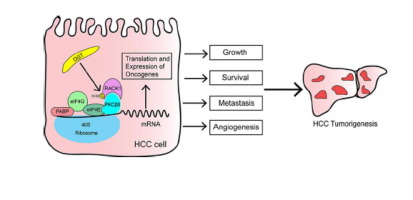当前位置:
X-MOL 学术
›
J. Hepatol.
›
论文详情
Our official English website, www.x-mol.net, welcomes your
feedback! (Note: you will need to create a separate account there.)
O-GlcNAcylation of RACK1 promotes hepatocellular carcinogenesis
Journal of Hepatology ( IF 26.8 ) Pub Date : 2018-02-15 , DOI: 10.1016/j.jhep.2018.02.003 Fangfang Duan , Hao Wu , Dongwei Jia , Weicheng Wu , Shifang Ren , Lan Wang , Shushu Song , Xinying Guo , Fenglin Liu , Yuanyuan Ruan , Jianxin Gu
Journal of Hepatology ( IF 26.8 ) Pub Date : 2018-02-15 , DOI: 10.1016/j.jhep.2018.02.003 Fangfang Duan , Hao Wu , Dongwei Jia , Weicheng Wu , Shifang Ren , Lan Wang , Shushu Song , Xinying Guo , Fenglin Liu , Yuanyuan Ruan , Jianxin Gu

|
Aberrant oncogenic mRNA translation and protein -linked β-N-acetylglucosaminylation (-GlcNAcylation) are general features during tumorigenesis. Nevertheless, whether and how these two pathways are interlinked remain unknown. Our previous study indicated that ribosomal receptor for activated C-kinase 1 (RACK1) promoted chemoresistance and growth in hepatocellular carcinoma (HCC). The aim of this study is to examine the role of RACK1 -GlcNAcylation in oncogene translation and HCC carcinogenesis. The site(s) of RACK1 for -GlcNAcylation was mapped by mass spectrometry analysis. HCC cell lines were employed to examine the effects of RACK1 -GlcNAcylation on the translation of oncogenic factors and behaviors of tumor cells . Transgenic knock-in mice were used to detect the role of RACK1 -GlcNAcylation in modulating HCC tumorigenesis . The correlation of RACK1 -GlcNAcylation with tumor progression and relapse were analyzed in clinical HCC samples. We found that ribosomal RACK1 was highly modified by -GlcNAc at Ser122. -GlcNAcylation of RACK1 enhanced its protein stability, ribosome binding and interaction with PKCβII (PRKCB), leading to increased eukaryotic translation initiation factor 4E phosphorylation and translation of potent oncogenes in HCC cells. Genetic ablation of RACK1 -GlcNAcylation at Ser122 dramatically suppressed tumorigenesis, angiogenesis, and metastasis and in diethylnitrosamine (DEN)-induced HCC mouse model. Increased RACK1 -GlcNAcylation was also observed in HCC patient samples and correlated with tumor development and recurrence after chemotherapy. These findings demonstrate that RACK1 acts as key mediator linking -GlcNAc metabolism to cap-dependent translation during HCC tumorigenesis. Targeting RACK1 -GlcNAcylation provides promising options for HCC treatment. -GlcNAcylation of ribosomal receptor for activated C-kinase 1 at the amino acid serine122 promotes its stability, ribosome localization and interaction with the protein kinase, PKCβII, thus driving the translation of oncogenes and tumorigenesis of hepatocellular carcinoma. Increased -GlcNAcylation of ribosomal receptor for activated C-kinase 1 is positively correlated with tumor growth, metastasis and recurrence in patients with hepatocellular carcinoma.
中文翻译:

RACK1的O-GlcNAc酰化促进肝细胞癌变
异常的致癌 mRNA 翻译和蛋白质连接的 β-N-乙酰葡糖胺酰化 (-GlcNAcylation) 是肿瘤发生过程中的一般特征。然而,这两条途径是否以及如何相互关联仍然未知。我们之前的研究表明,激活的 C 激酶 1 (RACK1) 的核糖体受体可促进肝细胞癌 (HCC) 的化疗耐药性和生长。本研究的目的是探讨 RACK1 -GlcNAcylation 在癌基因翻译和 HCC 癌变中的作用。通过质谱分析绘制 RACK1 的 -GlcNAc 酰化位点。采用HCC细胞系来研究RACK1-GlcNAcylation对致癌因子翻译和肿瘤细胞行为的影响。转基因敲入小鼠用于检测 RACK1 -GlcNAcylation 在调节 HCC 肿瘤发生中的作用。在临床 HCC 样本中分析 RACK1 -GlcNAcylation 与肿瘤进展和复发的相关性。我们发现核糖体 RACK1 在 Ser122 处被 -GlcNAc 高度修饰。 RACK1 的 GlcNAc 酰化增强了其蛋白质稳定性、核糖体结合以及与 PKCβII (PRKCB) 的相互作用,导致 HCC 细胞中真核翻译起始因子 4E 磷酸化和强癌基因翻译增加。在二乙基亚硝胺 (DEN) 诱导的 HCC 小鼠模型中,RACK1 -GlcNAcylation Ser122 的基因消除可显着抑制肿瘤发生、血管生成和转移。在 HCC 患者样本中也观察到 RACK1 -GlcNAc 酰化增加,并且与化疗后肿瘤的发展和复发相关。这些发现表明,RACK1 在 HCC 肿瘤发生过程中充当将 -GlcNAc 代谢与帽依赖性翻译联系起来的关键介质。靶向 RACK1 -GlcNAcyllation 为 HCC 治疗提供了有希望的选择。 -激活的 C-激酶 1 的核糖体受体在氨基酸丝氨酸 122 处的 GlcNA 酰化可促进其稳定性、核糖体定位以及与蛋白激酶 PKCβII 的相互作用,从而驱动癌基因的翻译和肝细胞癌的肿瘤发生。活化的C-激酶1的核糖体受体的-GlcNAc酰化增加与肝细胞癌患者的肿瘤生长、转移和复发呈正相关。
更新日期:2018-02-15
中文翻译:

RACK1的O-GlcNAc酰化促进肝细胞癌变
异常的致癌 mRNA 翻译和蛋白质连接的 β-N-乙酰葡糖胺酰化 (-GlcNAcylation) 是肿瘤发生过程中的一般特征。然而,这两条途径是否以及如何相互关联仍然未知。我们之前的研究表明,激活的 C 激酶 1 (RACK1) 的核糖体受体可促进肝细胞癌 (HCC) 的化疗耐药性和生长。本研究的目的是探讨 RACK1 -GlcNAcylation 在癌基因翻译和 HCC 癌变中的作用。通过质谱分析绘制 RACK1 的 -GlcNAc 酰化位点。采用HCC细胞系来研究RACK1-GlcNAcylation对致癌因子翻译和肿瘤细胞行为的影响。转基因敲入小鼠用于检测 RACK1 -GlcNAcylation 在调节 HCC 肿瘤发生中的作用。在临床 HCC 样本中分析 RACK1 -GlcNAcylation 与肿瘤进展和复发的相关性。我们发现核糖体 RACK1 在 Ser122 处被 -GlcNAc 高度修饰。 RACK1 的 GlcNAc 酰化增强了其蛋白质稳定性、核糖体结合以及与 PKCβII (PRKCB) 的相互作用,导致 HCC 细胞中真核翻译起始因子 4E 磷酸化和强癌基因翻译增加。在二乙基亚硝胺 (DEN) 诱导的 HCC 小鼠模型中,RACK1 -GlcNAcylation Ser122 的基因消除可显着抑制肿瘤发生、血管生成和转移。在 HCC 患者样本中也观察到 RACK1 -GlcNAc 酰化增加,并且与化疗后肿瘤的发展和复发相关。这些发现表明,RACK1 在 HCC 肿瘤发生过程中充当将 -GlcNAc 代谢与帽依赖性翻译联系起来的关键介质。靶向 RACK1 -GlcNAcyllation 为 HCC 治疗提供了有希望的选择。 -激活的 C-激酶 1 的核糖体受体在氨基酸丝氨酸 122 处的 GlcNA 酰化可促进其稳定性、核糖体定位以及与蛋白激酶 PKCβII 的相互作用,从而驱动癌基因的翻译和肝细胞癌的肿瘤发生。活化的C-激酶1的核糖体受体的-GlcNAc酰化增加与肝细胞癌患者的肿瘤生长、转移和复发呈正相关。











































 京公网安备 11010802027423号
京公网安备 11010802027423号